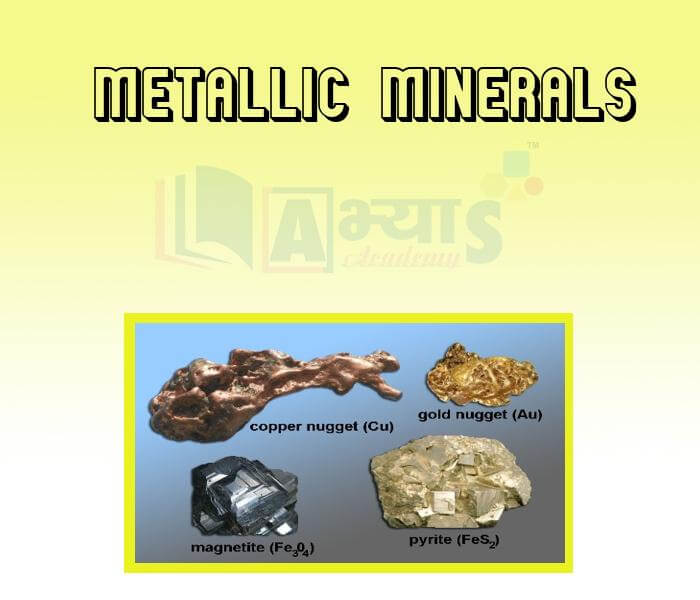Metallic Minerals










Metallic Minerals
Classification of minerals: Minerals are mainly classified as Metallic, Non-Metallic and Energy Minerals.
Metallic Minerals: Minerals containing metals are called metallic minerals, like gold, silver, tungsten, etc . These are further classified as-
Ferrous Minerals: Metallic minerals having iron content are called ferrous minerals. A ferro - alloy is an alloy of iron with some other metals. These minerals account for about three-fourths of the total value of the production of metallic minerals. After meeting the internal demands, India exports a fairly large amount of ferrous minerals. These minerals have much importance as they -provide a strong base for the development of metallurgical industries . The distribution of ferrous minerals — Iron ore and manganese is discussed below:
Non - Ferrous Minerals: India has only a few reserves of non-ferrous minerals that are not very adequate. However, these minerals which include (e.g. copper, zinc, bauxite and gold) play a vital role in various industries, i.e. metallurgical, engineering and electrical industries. The distribution of non-ferrous minerals i.e. copper and bauxite are:
Interesting Fact about Aluminium: After the discovery of aluminium, Emperor Napoleon Ill wore buttons and hooks on his clothes made of aluminium. He served food to his more important guests in aluminium utensils and the less honourable ones were served in gold and silver utensils. Thirty years after this incident, aluminium bowls were most common with the beggars in Paris.
The famous Bailadila range of Hills in the Bastar district of Chattisgarh is famous for its _____________ | |||
| Right Option : B | |||
| View Explanation | |||
Manganese ore in bulk is exported from _________________ | |||
| Right Option : D | |||
| View Explanation | |||
From which of the following mines iron ore is exported to Japan through Vishakhapatnam port ? | |||
| Right Option : D | |||
| View Explanation | |||
Students / Parents Reviews [10]
Abhyas Methodology is very good. It is based on according to student and each child manages accordingly to its properly. Methodology has improved the abilities of students to shine them in future.

Manish Kumar
10thA marvelous experience with Abhyas. I am glad to share that my ward has achieved more than enough at the Ambala ABHYAS centre. Years have passed on and more and more he has gained. May the centre flourish and develop day by day by the grace of God.

Archit Segal
7thIt has a great methodology. Students here can get analysis to their test quickly.We can learn easily through PPTs and the testing methods are good. We know that where we have to practice

Barkha Arora
10thIt was good as the experience because as we had come here we had been improved in a such envirnment created here.Extra is taught which is beneficial for future.

Eshan Arora
8thMy experience was very good with Abhyas academy. I am studying here from 6th class and I am satisfied by its results in my life. I improved a lot here ahead of school syllabus.

Ayan Ghosh
8thBeing a parent, I saw my daughter improvement in her studies by seeing a good result in all day to day compititive exam TMO, NSO, IEO etc and as well as studies. I have got a fruitful result from my daughter.

Prisha Gupta
8thIt was a good experience with Abhyas Academy. I even faced problems in starting but slowly and steadily overcomed. Especially reasoning classes helped me a lot.

Cheshta
10thAbhyas is a complete education Institute. Here extreme care is taken by teacher with the help of regular exam. Extra classes also conducted by the institute, if the student is weak.

Om Umang
10thAbout Abhyas metholodology the teachers are very nice and hardworking toward students.The Centre Head Mrs Anu Sethi is also a brilliant teacher.Abhyas has taught me how to overcome problems and has always taken my doubts and suppoeted me.

Shreya Shrivastava
8thI have spent a wonderful time in Abhyas academy. It has made my reasoning more apt, English more stronger and Maths an interesting subject for me. It has given me a habbit of self studying
